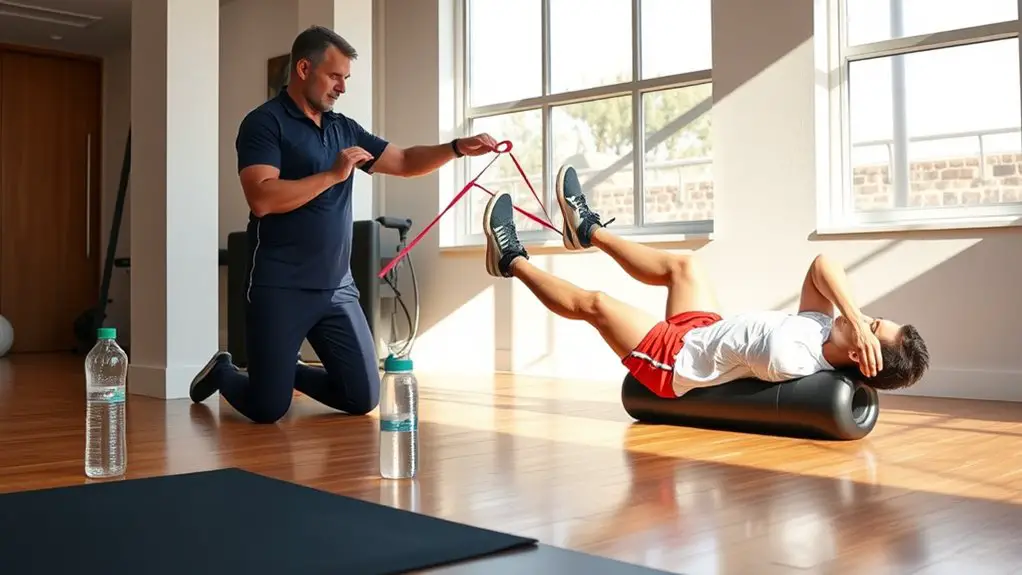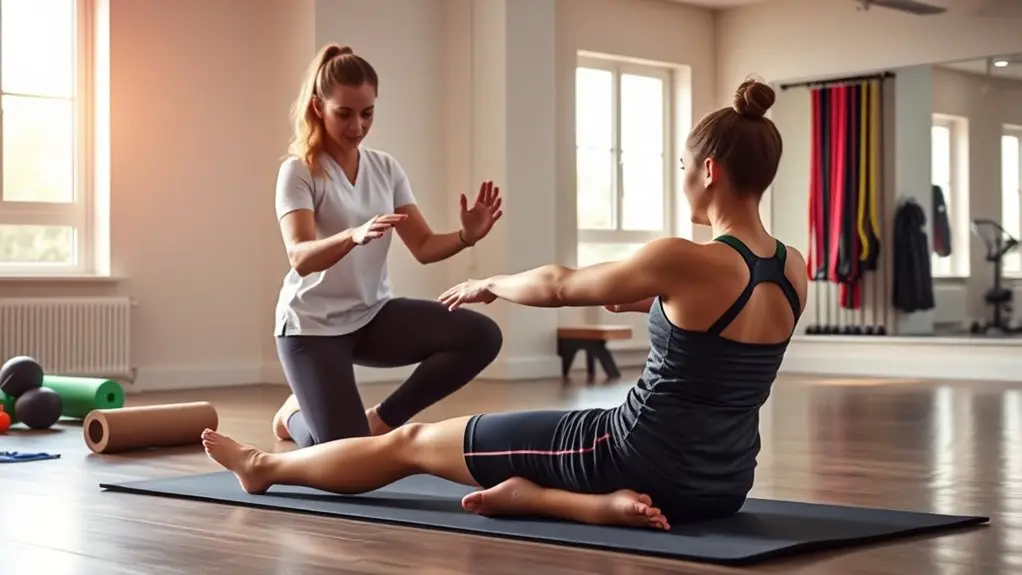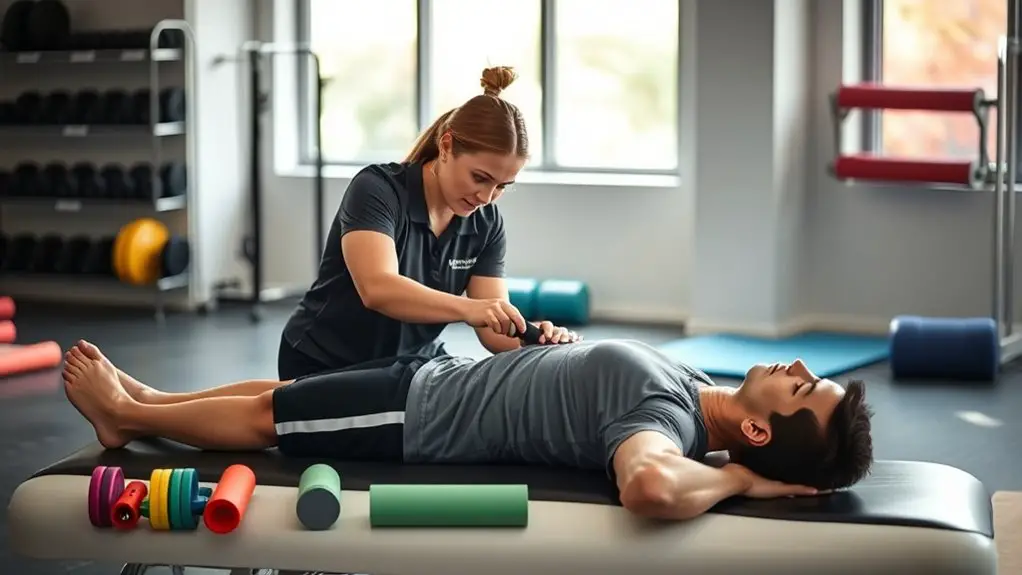The Role of Physical Therapy in Gym Recovery

Physical therapy plays an essential role in your gym recovery. It helps you regain strength, improve mobility, and prevents future injuries with customized rehabilitation plans. Therapists assess your individual needs, offering exercises that enhance flexibility and stability. Techniques like manual therapy and soft tissue mobilization provide pain relief and facilitate a safe return to workouts. With their expert guidance, you can stay on track and avoid setbacks. Discover more about how it can transform your recovery journey.
Understanding Physical Therapy and Its Benefits

When you think about gym recovery, understanding physical therapy can be a game-changer. Many people have misconceptions about therapy, assuming it’s only for serious injuries or older adults. In reality, physical therapy offers an extensive benefits overview that can enhance your recovery process, regardless of your fitness level.
It focuses on preventing injuries, improving mobility, and helping you regain strength after workouts. By working with a trained therapist, you’ll learn personalized techniques tailored to your needs, ensuring you stay safe while pushing your limits.
Therapists can also provide guidance on proper techniques to avoid future injuries, dispelling the myth that therapy is solely for rehabilitation. Instead, consider it a proactive approach to maintaining your overall well-being. Embracing physical therapy in your gym recovery routine can help you stay on track, allowing you to enjoy your fitness journey while minimizing risks.
How Physical Therapy Enhances Recovery
Physical therapy plays a vital role in enhancing your recovery by focusing on injury prevention techniques. By creating customized rehabilitation plans, it addresses your specific needs and goals. This tailored approach not only speeds up healing but also helps you get back to your workouts safely.
Injury Prevention Techniques
While you might focus on lifting weights and boosting endurance in the gym, incorporating injury prevention techniques through physical therapy can greatly enhance your recovery. By emphasizing muscle strengthening and flexibility training, you can build a solid foundation that reduces the risk of injury. Physical therapists can guide you in exercises tailored to enhance your strength, ensuring you’re not overexerting specific muscle groups. Additionally, they’ll introduce flexibility training to improve your range of motion, making your workouts safer and more effective. This proactive approach helps identify potential weaknesses before they become issues, allowing you to maintain your fitness journey with confidence. Prioritizing these techniques will not only enhance your recovery but also lead to a more sustainable gym experience.
Customized Rehabilitation Plans
Customized rehabilitation plans are essential for optimizing your recovery after an injury or intense workout. These plans focus on your unique needs and help you achieve your rehabilitation goals safely. With the guidance of a physical therapist, you’ll engage in personalized exercises that cater to your specific condition and fitness level.
- Address your individual injury or pain
- Improve flexibility and strength
- Enhance mobility and stability
- Prevent future injuries
- Boost your overall performance
Common Injuries Treated With Physical Therapy

When you hit the gym regularly, sprains and strains can become a common issue. Overuse injuries might also sneak up on you, causing discomfort and setbacks. Understanding these injuries and how physical therapy can help is key to maintaining your fitness journey.
Sprains and Strains
Sprains and strains are among the most common injuries people face during physical activities, and they can considerably hinder your progress in the gym. These acute injuries often result from improper technique or overexertion. Physical therapy can play a vital role in your recovery, employing various rehabilitation strategies to help you regain strength and flexibility.
- Tailored exercise programs
- Manual therapy techniques
- Education on proper form
- Injury prevention strategies
- Gradual return to activity
Overuse Injuries
While sprains and strains are acute injuries that can sideline your gym routine, overuse injuries are just as common and often more insidious. These injuries develop gradually, often due to repetitive movements that lead to chronic pain and muscle fatigue. You might notice discomfort in your joints or muscles after workouts, and ignoring these signs can worsen your condition. Physical therapy plays an essential role in addressing overuse injuries. A therapist can assess your movement patterns, recommend modifications, and develop a personalized rehabilitation plan to help you recover safely. Incorporating strength and flexibility exercises can also prevent future injuries. Prioritizing your body’s signals and seeking help early can guarantee you stay on track with your fitness goals without compromising your health.
The Importance of Customized Treatment Plans
Customized treatment plans are essential for effective recovery in physical therapy, especially since each individual’s body and injury respond differently to treatment. By focusing on your unique needs, a customized approach guarantees safer and more effective recovery. This starts with personalized assessments that identify your specific challenges and goals.
Here are some key benefits of customized treatment plans:
- Targeted approach: Focus on your specific injuries and recovery needs.
- Tailored exercises: Incorporate movements that suit your current fitness level.
- Progress tracking: Regular assessments help monitor improvement and adjust plans.
- Enhanced safety: Minimize the risk of further injury by following a plan designed for you.
- Motivation: A plan that resonates with your goals keeps you engaged and committed.
Embracing a customized treatment plan can make all the difference in your physical therapy journey, guaranteeing a safer and more efficient recovery.
Techniques Used in Physical Therapy

Physical therapy employs a variety of techniques that cater to individual recovery needs, ensuring a thorough approach to healing. Manual therapy focuses on hands-on techniques to relieve pain and improve mobility. Therapeutic exercises are tailored to enhance strength and flexibility, while pain management strategies help alleviate discomfort. Modality application, such as heat or cold therapy, aids in reducing inflammation and promoting recovery.
Functional training is essential for getting you back to your daily activities safely, and neuromuscular re-education helps restore proper movement patterns. Postural alignment techniques can correct imbalances, while movement analysis identifies specific areas needing improvement. For athletes, sports-specific training prepares you for the demands of your sport. Finally, soft tissue mobilization techniques help release tension and improve circulation. By integrating these methods, physical therapy creates a thorough recovery plan that prioritizes your safety and well-being.
Incorporating Physical Therapy Into Your Routine
Incorporating physical therapy into your routine can markedly enhance your recovery and overall fitness. By integrating physical therapy techniques, you can optimize your gym recovery strategies and promote a safer workout experience. Here are some practical ways to include physical therapy in your regimen:
- Schedule regular assessments to identify areas needing attention.
- Use therapeutic exercises tailored to your specific needs.
- Implement stretching routines to improve flexibility and prevent injuries.
- Learn proper lifting techniques to reduce strain on muscles and joints.
- Incorporate foam rolling or massage therapy to relieve muscle tension.
The Role of Physical Therapists in Injury Prevention
While you may focus on your workout routine, the guidance of a physical therapist can be essential in preventing injuries. They can conduct a thorough injury assessment to identify any weaknesses or imbalances that could lead to problems down the line. By understanding your specific needs, they’ll develop a tailored plan to keep you safe and performing at your best.
Preventive exercises are a key component of injury prevention. A physical therapist can teach you targeted exercises that strengthen vulnerable areas, improve flexibility, and enhance overall stability. Incorporating these exercises into your routine not only minimizes the risk of injury but also boosts your performance in the gym.
Regular check-ins with a physical therapist can help you stay on track and make necessary adjustments to your regimen. With their expertise, you can confidently pursue your fitness goals while safeguarding your body against potential injuries.
Success Stories: How Physical Therapy Transformed Recovery
Have you ever wondered how physical therapy can dramatically change the recovery journey for athletes and fitness enthusiasts? Many individuals have experienced success stories that showcase the transformative journeys made possible through tailored physical therapy programs. Whether it’s recovering from an injury or enhancing performance, these success stories highlight the benefits.
- Personalized treatment plans that cater to your specific needs
- Access to expert guidance for safe movements
- Improved strength and flexibility to prevent future injuries
- A supportive environment that fosters motivation
- Education on injury management and prevention strategies
Frequently Asked Questions
How Long Does a Typical Physical Therapy Session Last?
A typical physical therapy session lasts around 45 minutes to an hour. This session duration allows for a thorough assessment and effective treatment. Depending on your condition, therapy frequency might be once or twice a week. It’s important to prioritize safety, so your therapist will tailor the sessions to your specific needs, ensuring you progress without risking further injury. Always communicate any concerns during your sessions to enhance your recovery process.
Will Insurance Cover My Physical Therapy Treatments?
Imagine you’ve sprained your ankle while running and need physical therapy. You’re probably wondering if insurance will cover your treatment costs. Generally, insurance coverage depends on your plan and the specific therapies prescribed. For instance, if your doctor recommends sessions for recovery, many insurers will assist with the expenses. It’s crucial to check with your provider beforehand to guarantee you’re financially prepared and to know what treatments they’ll cover for your safety.
Can I Do Physical Therapy Exercises at Home?
Yes, you can definitely do physical therapy exercises at home! Many people find that home exercises provide significant recovery benefits, as they can help maintain strength and flexibility. Just make sure you follow the instructions given by your therapist for safety. Start slow, listen to your body, and don’t hesitate to reach out if you experience any pain. Consistency is key, so try to incorporate these exercises into your routine regularly.
How Do I Choose the Right Physical Therapist?
Choosing the right physical therapist is vital for your safety and recovery. Start by verifying their credentials; check for licenses and any certifications. It’s also important to take into account their treatment specialization—do they focus on your specific needs? You want someone experienced in the area you’re dealing with. Don’t hesitate to ask potential therapists about their approach and techniques to guarantee you feel comfortable and supported throughout your healing process.
What Should I Wear for a Physical Therapy Session?
Did you know that over 60% of people find their physical therapy sessions more effective when wearing appropriate attire? For your session, opt for comfortable, loose-fitting clothing that allows for easy movement. Consider wearing breathable fabrics to keep cool. Don’t forget comfortable footwear, as it provides support during exercises. Safety’s important, so avoid anything too tight or restrictive that could hinder your mobility or cause discomfort.





